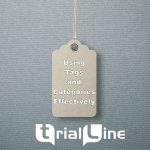Today, we celebrate the life of Supreme Court Justice Ruth Bader Ginsburg (1933-2020). Enjoy this TrialLine detailing some of the highlights of her life and amazing career.
Category: Blog
Engage Your Audience Better with Visual Trial Timelines
Research has shown that one of the most effective ways to communicate information clearly and persuasively, is through the use of visual cues. There are a number of benefits to using visuals, all of which should be very interesting to attorneys:
- Better retention – The brain is extremely good at encoding images and recalling them at a later time. Studies have shown that connecting concepts and ideas to meaningful images can improve the recall of those concepts and ideas.
- Faster comprehension – The human brain is capable of processing images very quickly, and of gleaning a remarkable amount of detail in just a brief period of time.
- Deeper understanding – Images communicate information without using language, which engages the mind in non-linguistic ways, which can lead to deeper understanding of a subject, and even emotional responses.
Combine the benefits of using visual aids with the tendency of human beings to think linearly, and it becomes clear how using a fact chronology or visual trial timeline in your legal work, can be a powerful way not only to communicate the important facts of your case to others, but also to solidify and understand the facts in your own mind. Continue reading “Engage Your Audience Better with Visual Trial Timelines”
Using Tags and Categories Effectively in TrialLine
One of the most helpful features that TrialLine provides is the ability to sort which events are displayed along your timeline and which are not, by filtering out events based on what category they are included in, and/or what tags are attached to them.
Controlling the way that the facts and details of your case are presented is the key to creating the narrative of your case. And this is important for a number or reasons.
Not only is it the key to creating a compelling and efficient narrative when in front of a judge or jury, it’s also a key aspect of your case preparation. Remember, sometimes it’s the paring down of information that is required to clarify a story, or bring to light important information. Continue reading “Using Tags and Categories Effectively in TrialLine”
How to Create Effective Trial Visuals for Your Next Case
Trial visuals and courtroom graphics can enhance your case and help you tell your client’s story in an interactive and captivating way. Creating a timeline is an effective way to do just that.
With TrialLine, you can organize your case data and maximize visuals at the same time. While most visual demonstrative evidence is expensive and time-consuming, TrialLine offers you a better way. Continue reading “How to Create Effective Trial Visuals for Your Next Case”
Creating Fact Chronologies in TrialLine
You have a complicated legal matter with multiple witnesses, hundreds of facts and thousands of documents. Litigating this matter is a daunting prospect, but you’ve done the work and set yourself up so that your case is well organized and manageable.
You’ve taken that big, imposing matter and broken it down into smaller, more easily managed parts, by creating lists of all of the players and important evidence in your case. And you’ve listed all of the issues that need to be addressed, and linked them to the relevant players and evidence.
Now that you have identified the component parts of your case, it’s time to create a chronology that lays out all of the facts. Continue reading “Creating Fact Chronologies in TrialLine”





